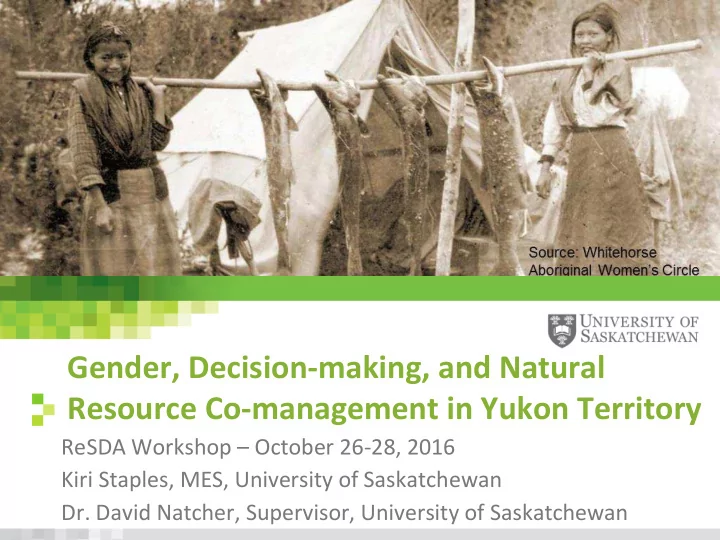

Gender, Decision-making, and Natural Resource Co-management in Yukon Territory ReSDA Workshop – October 26-28, 2016 Kiri Staples, MES, University of Saskatchewan www.usask.ca Dr. David Natcher, Supervisor, University of Saskatchewan
Overview • Background • Methods • Overview of Findings: • Importance of female representation • Engaging women’s knowledge of the land • Experiences with board decision-making • Recommendations • Concluding thoughts www.usask.ca
The Yukon Territory • Over 36,000 people • First Nations citizens make up 25% of the population • 14 First Nations (11 self- governing) www.usask.ca
Co-management in northern Canada “Co -management can be thought of as a spectrum of institutional arrangements in which management responsibilities are shared between users (who may or may not be community-based) and government” ( Yandle, 2003, pg.180) www.usask.ca
Co-Management Boards (2012) Appointments Yukon Territory Male Female Porcupine Caribou Management Board 7 2 Yukon Fish and Wildlife Management Board 10 2 Salmon Sub-Committee 6 3 Carcross/Tagish RRC 5 1 Alsek RRC 5 1 Carmacks RRC 4 2 Dan Keyi RRC 5 1 Dawson RRC 5 1 Laberge RRC 4 1 Mayo RRC 5 1 North Yukon RRC 5 0 Selkirk RRC 6 0 Teslin RRC 9 1 76 (83%) 16 (17%) Gender Representation on Yukon Co-Management Boards (modified from Natcher, 2013) www.usask.ca
Methods • Focused on wildlife co-management boards in the Yukon • 3 regional boards, 5 community-based boards • Written surveys • Semi-structured interviews • Past and present, board and staff members • Mostly women (70%) • Range of age groups • First Nations and non-First Nations individuals www.usask.ca
Participant demographics (surveys and interviews) Male (31%) Female (69%) 1 0 Age 20-29 1 (3%) 30-39 7 (20%) 1 6 4 7 40-49 11 (31.5%) 1 3 50-59 4 (11.5%) 4 8 60+ 12 (34%) 1 11 First Nations/Non-First Nation First Nations 12 (34%) Non-First Nations 23 (66%) 10 13 www.usask.ca
Importance of female representation 1. Women's presence is important because board member diversity is important “I’m surrounded by men with grey hair. You know, like it’s the same thing over and over and over again and it’s just that then you create this sort of homogenous type of approach to things.” www.usask.ca
Importance of female representation 2. Women's representation positively influences the decision-making process 3. Women bring a unique set of perspectives, knowledge, and experiences to the table, based on their roles in the community and on the land www.usask.ca
“When you look at like a traditional fish camp perspective, the majority of the work, anyways in my culture, is done by the woman. And so you know we’re the ones cutting the fish, seeing the fish, doing all the work with them, hanging them, drying them, preparing them. Normally the men are catching the fish but it’s that type of involvement….me bringing that perspective of what it’s like to have run a fish camp…I think I bring a very different, and I think I bring more of an emotional…perspective to the table” www.usask.ca
“Women you know a lot of them are harvesters of a different nature, you know the berry patches, and the roots and the medicinal plants, so the nature of what brings them onto the land brings them to different places than the men” www.usask.ca
Engaging women's knowledge of the land “Activities that women undertake like ‘gathering’ type activities are considered very occasionally, but not like ‘hunting/fishing/trapping’ activities. Gathering is a fascinating consideration in the grand scheme because it is traditional, important, and particularly because products being ‘gathered’ are sessile, activities such as exploration, mining, roads, and even tourism can have significant effects on them.” www.usask.ca
Experiences with decision-making on co-management boards a) Logistical barriers (e.g. time commitments) b) Cultural barriers (e.g. speaking out assertively in front of elders) c) Skills and knowledge (e.g. lacking certain types of land-based knowledge) d) Attitudes and personalities of other board members (e.g. more assertive individuals dominating the discussion) www.usask.ca
Women “proving” themselves “It’s almost like you’re having to prove [yourself] you know and work harder and get acceptance….always work harder, always” “You have to act like a man, you have to talk like a man in a lot of ways, you know especially being a young woman, um, I found that how do I negotiate or navigate in this environment because I’m surrounded by 50 year old men” www.usask.ca
Recommendations 1. Consider providing training for board chair members 2. More responsive to logistical barriers 3. Consider the types of knowledge that is being engaged in relation to a board’s mandate 4. Position for youth on boards 5. Future research – informal participation in decision-making www.usask.ca
“In order for environmental change in the Arctic to be addressed, innovative and robust policies must be developed that are holistic, flexible, culturally relevant and sensitive to gender” (Kafarowski, 2005, pg.16). www.usask.ca
Thank you! www.usask.ca
Recommend
More recommend